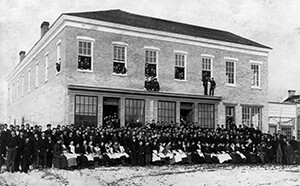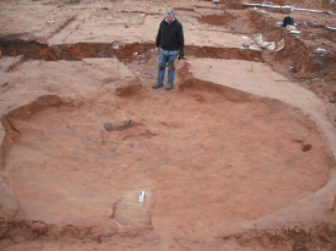Our Mission
The Museum of Peoples and Cultures exists to serve the academic mission of BYU and care for the anthropological, archaeological, and ethnographic collections in the custody of the University.
The Museum of Peoples and Cultures at BYU serves as a Teaching Museum, providing inspiration to students for a lifelong journey of learning and service. It serves as a mentor to students, engaging them in collections-focused activities that align with the core principles of BYU education – to strengthen spirituality, broaden intellectual horizons, and foster character development.
These activities are designed to simultaneously benefit the scholarly community, the LDS community, and the general public. The museum strives to uphold the highest standards of stewardship and public trust in its mission and endeavors.
The Museum supports this mission by:
- Collecting, preserving, and caring for material objects that document the diversity of human experiences and reflect the multi-faceted fabric of the world’s cultures past and present
- Providing a professional learning environment for BYU students through a broad range of instruction in both formal and informal settings; through programs that enable student participation; and through example and role-modeling
- Facilitating teaching and research on peoples and cultures by BYU faculty, staff, students, and by members of the scholarly community in peer institutions
- Creating new knowledge through scholarly research including field activities, research, and exhibitions
- Educating museum visitors about peoples and cultures as appropriate to the Museum’s holdings and collecting scope
The Museum gratefully acknowledges the generous support of the Utah Division of Arts and Museums through a general operating support grant.

Brief History of Museums at BYU

Museum work at Brigham Young Academy began as early as 1879, when James E. Talmage was appointed curator of the Academy Museum. His notes show that the museum collected natural history, geological, and archaeological objects. By the 1930s, BYU’s museum collections were housed in Room D of the Education Building (now the Provo City Library). Over time, these collections were divided into what are now BYU’s four museums: the Museum of Paleontology, the Museum of Art, the Monte L. Bean Life Science Museum, and the Museum of Peoples and Cultures (MPC). The MPC serves as the university’s museum of archaeology and anthropology.
History of the Museum of Peoples and Cultures

BYU’s Archaeology Department was established in 1946, and as its fieldwork expanded, a dedicated archaeology museum was created to house and display its growing collections. The museum was first located in the lower floor of the Eyring Science Center, then moved to the Maeser Building in 1961. In 1981, it relocated to Allen Hall, where it received its current name. Before moving to Allen Hall, the museum’s collections were kept and displayed in several earlier locations, including the Lewis Building on Center Street (no longer standing), the Academy Building on University Avenue (now the Provo City Library), and the Maeser Building on campus.

The museum has continued to grow and improve over the years, earning recognition for its excellence. Recent honors include a State Certificate Award for Excellence in All Areas of Museum Operations and the 2011 Award of Merit from the American Association for State and Local History. Since 2000, the Museum of Peoples and Cultures (MPC) has received more than $250,000 in federal and state research grants, along with $1.5 million in object and cash donations that have greatly enhanced its collections. All MPC exhibits are designed and installed by students in BYU’s Museum Certificate Program. Public programs—such as our popular date nights and Family Home Evening events—are also created and led by student employees and volunteers.
Allen Hall Building History

Allen Hall was built in the late 1930s as a men’s dormitory and later served as women’s housing during World War II. In the 1960s, it was converted for use as a Language Training Mission—the predecessor to today’s Missionary Training Center. This rich history could still be seen in the building’s structure: the museum galleries once occupied the former common and dining rooms, the classroom was the old kitchen, and most offices were once dorm rooms. The Museum of Peoples and Cultures was housed in Allen Hall from 1981 until its move to its current location on Canyon Road in 2015.

Paul Stavast
(801) 422-0018
paul_stavast@byu.edu

Ann Rowan
(801) 422-0022
mpc_programs@byu.edu

Scott Ure
(801) 422-0742
scott_ure@byu.edu

Hailey Sanders
(801) 422-1414
mpc-mgr@byu.edu
Newsroom

Dia de los Muertos
Our annual Dia de los Muertos celebration was Monday, November 1st. Face painting, live music, crafts, and fun treats all contributed to the unforgettable evening. Here's what The Daily Universe wrote about this event.

Professionalism in Cultural Resources Consulting Award
One of our outstanding faculty in the archaeology department, Rich Talbot, was awarded the Professionalism in Cultural Resources Consulting Award by PLPCO (Utah's Public Lands Policy Coordinating Office).

Night at the Museums
Another annual favorite, this year's Night at the Museums offered visitors the chance to solve a riddle and collect a sticker at each of BYU's museums. Our student researchers and employees even presented on various collections, projects, and technology at the museum!

Artifact or Artifice?
Featured on both campus and local news channels, read about how one of our students analyzed microscopic details to identify forgeries as part of her fascinating research project in the museum's Mesoamerican greenstone collection.
Newsletter
Every month the Museum sends out an electronic newsletter highlighting upcoming events, programs, and other exciting news. To be added onto our email list and receive our monthly emails, please submit your email below.
IS THE MUSEUM OPEN ON SATURDAYS?
No, we are only open during the week. Our hours during the school year are:
Monday - Friday : 9am - 5pm
Closed Saturday and Sunday
HOW DO I SCHEDULE A TOUR?
To schedule a tour, please contact the MPC Education Office at (801) 422-0022 or mpc_programs@byu.edu
HOW DO I FIND OUT ABOUT UPCOMING EVENTS?
Please visit the Programs and Events section of our web page. All programs and events will be listed with information as the dates are solidified.
I HAVE AN ARTIFACT I WOULD LIKE TO DONATE TO THE MUSEUM. HOW CAN I DONATE IT?
To donate objects and artifacts, email our registrar at mpc-collections@byu.edu. Please include pictures of the artifact, the location of its origin, the date of the object and any other important information about the artifact so that we can catalogue it appropriately. *We cannot accept artifacts without this information.
DOES THE MUSEUM ACCEPT DONATIONS?
Yes. Monetary donations can be placed in our donation box in the foyer of the museum or online at give.byu.edu/mpc. Your support helps us preserve collections, create meaningful exhibits, and provide v aluable educational opportunities. Thank you for making a difference in the work we do!
IS PHOTOGRAPHY ALLOWED IN THE EXHIBIT?
Yes, photography is allowed. You are free to take pictures in the exhibit. Don’t forget to add our hashtag: #mpc.